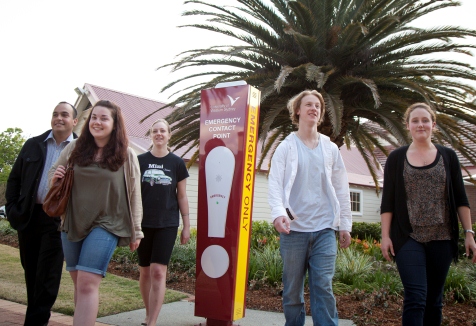Safety update

Students Samuel Camille, Fergus Loader, Jessica Mowle, Eliza Langford and Erin Cadogan think the new emergency contact points are a great idea.
Staff, students and visitors to the University may feel even safer when walking around their campus thanks to the introduction of a number emergency contact points on each campus. With a bright design that was selected by staff and student vote, the contact points are hard to miss in red, yellow and white, and they have been strategically positioned around each campus to provide a 24-hour direct link to a security officer in an emergency.
When an emergency contact point is activated, the closest Campus Safety and Security Officer will be sent to the site, while the person who raised the alarm will speak directly with security staff in the control room in full view of CCTV. The CCTV network plays a critical role in the overall security program at the University.
“While the overall criminal activity on our campuses is very low,” explains Adam Byrne, Director, Campus Safety and Security, “it was felt that the emergency contact points would permit a fast and effective method of communicating and seeking assistance in car parks and other areas that may not feature a high amount of pedestrian activity or may be remote from general University traffic.”
The installation of the emergency contact points is being well received by students. “It’s comforting to know that the University cares so much about the safety of students,” says student Erin Cadogan, who lives on campus.
“I think the emergency contact points are a good idea,” says Samuel Camille, a fourth-year Bachelor of Construction Management student. “I go to tutorials after dark and live on campus. I would use one if I felt threatened or uncomfortable.”
When designing the emergency contact points, one of the main considerations was functionality. As there were no devices available in Australia to suit, the University built its own. “The colours were specifically chosen and acceptance of the design was tested via a survey to staff and students in 2011,” says Adam. “The emergency contact points are wheelchair-accessible and, for those who are vision-impaired, the face features Braille.”
Other ways to access emergency assistance on-campus include calling 2300 from an internal phone or dialling 4736 0300 from your mobile to speak with Campus Safety and Security.
To find out where the emergency contact points are located on your campus, visit the Emergency Contact Points webpage (opens in a new window).
Mobile options:

